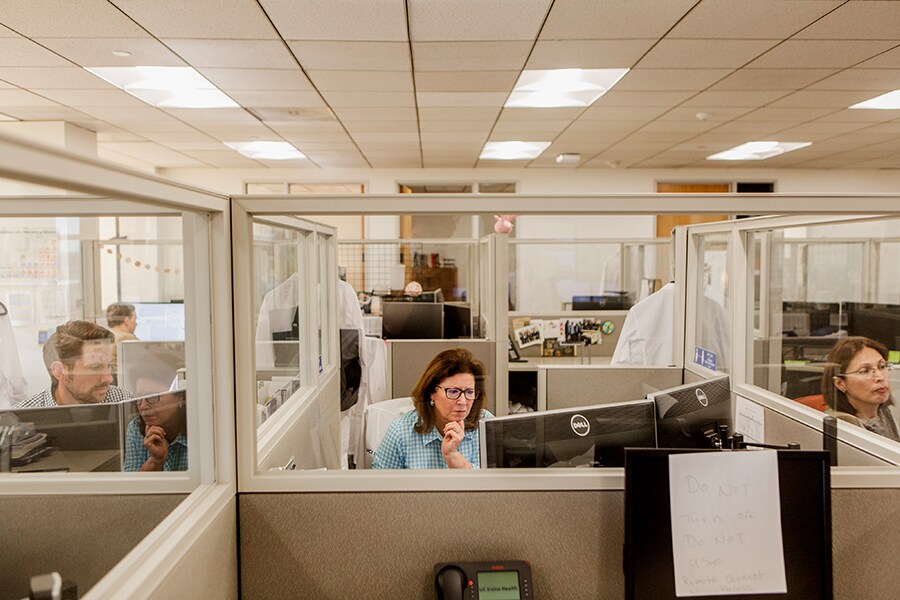Inside the office, desks should be 6 feet apart. If that isn’t possible, employers should consider erecting plastic shields around desks.
Seating should be barred in common areas.
And face coverings should be worn at all times.
These are among sweeping new recommendations from the Centers for Disease Control and Prevention on the safest way for American employers to reopen their offices to prevent the spread of the coronavirus.
If followed, the guidelines would lead to a far-reaching remaking of the corporate work experience. They even upend years of advice on commuting, urging people to drive to work by themselves, instead of taking mass transportation or carpooling, to avoid potential exposure to the virus.
The recommendations run from technical advice on ventilation systems (more open windows are most desirable) to suggested abolition of communal perks like latte makers and snack bins.
“Replace high-touch communal items, such as coffee pots, water coolers, and bulk snacks, with alternatives such as prepackaged, single-serving items,” the guidelines say.
And some border on the impractical, if not near impossible: “Limit use and occupancy of elevators to maintain social distancing of at least 6 feet.”
The CDC, the nation’s top public health agency, posted the guidelines on its website as states are beginning to lift their most stringent lockdown orders. Shops, restaurants, beaches and parks are reopening in phases. But white-collar office employees at all levels mostly continue to work from home, able to function effectively with laptops, video conferencing and Slack.
Some of the measures are in keeping with what some employers are already planning, but others may simply decide it’s easier to keep employees working from home.
“Companies, surprisingly, don’t want to go back to work,” said Russell Hancock, president and CEO of Joint Venture Silicon Valley, a nonprofit think tank that studies the region. “You will not see the drum beat and hue and cry and rush to get back to the office.”
Citing extreme examples like Twitter, which has said it may never return to corporate office space, Hancock said that he has heard similar things from both Silicon Valley companies and those outside the region. Many are planning to stay safe by thinning who is required to come to work, along with making plans consistent with the CDC guidelines.
“Incessant disinfecting of surfaces, cleansing out your HVAC,” he said, referring to the ventilation system, “opening windows, ventilation, all of those things.”
Tracy Wymer, vice president of workplace for Knoll Inc., a large office-furniture company, who has been in discussions with numerous companies about the safest way to reopen, said he agreed with much of what the CDC was advising but he added that a big part of successful reopening would involve employee compliance.
“The biggest factor is on the workforce and the personal responsibility they must take in making this reality work,” he said.
The CDC addressed that part, too, reiterating what has become a kind of national mantra: regular hand washing of at least 20 seconds no fist bumps or handshakes no face touching.
The CDC recommended that the isolation for employees should begin before they get to work — on their commute. In a stark change from public policy guidelines in the recent past, the agency said individuals should drive to work — alone. Employers should support this effort, the agency said.
“Offer employees incentives to use forms of transportation that minimize close contact with others, such as offering reimbursement for parking for commuting to work alone or single-occupancy rides.”
Smaller companies also have already been discussing how to reopen, some with the kinds of ideas the CDC is recommending. But there are distinctive challenges in many offices: for instance, those that do not have windows that open to the outside, permitting ventilation have little or no access to outdoor space or are small and open, with floor plans that were de rigueur just six months ago and now are verboten.
Peter Kimmel, the publisher of FMLink, a publication serving the facilities management industry, said that the CDC guidelines are “a good checklist of what needs to be done.”
But they also raise numerous questions, he said, including how social distancing will work. “This means many fewer workplaces per floor, reducing the density considerably. Where will the remaining workers be housed? Will the furniture work in the new layout?” he asked.
“While there are many solutions, these often require substantial thought and a budget that likely doesn’t exist,” he said.
Mobify, a Vancouver, British Columbia-based company with 40 employees that helps build digital storefronts for major retailers, moved back into its office last week and has already made a number of the changes recommended by the CDC. The building’s landlord now requires mask use in the elevator. Other changes the company made on its own.
“One person per table. We put arrows on the floor so people will go to the restroom one direction and come out the other. No more shared food. Sanitation stations with wipes,” said the company’s chief executive, Igor Faletski.
At the same time, he said, there may be a larger force at work: the impulses of the workers themselves.
“Since we opened up last week, only five employees have come in,” he said. ”Because the office is quite big, there was room for people to sit in different corners.”

 Offices at the University of California, Irvine’s infection prevention division, which installed sneeze guards for cubicles, in Orange, Calif., April 27, 2020. If followed, CDC guidelines for offices would transform the everyday experience of employees across the country, from executives to clerical workers.
Offices at the University of California, Irvine’s infection prevention division, which installed sneeze guards for cubicles, in Orange, Calif., April 27, 2020. If followed, CDC guidelines for offices would transform the everyday experience of employees across the country, from executives to clerical workers.